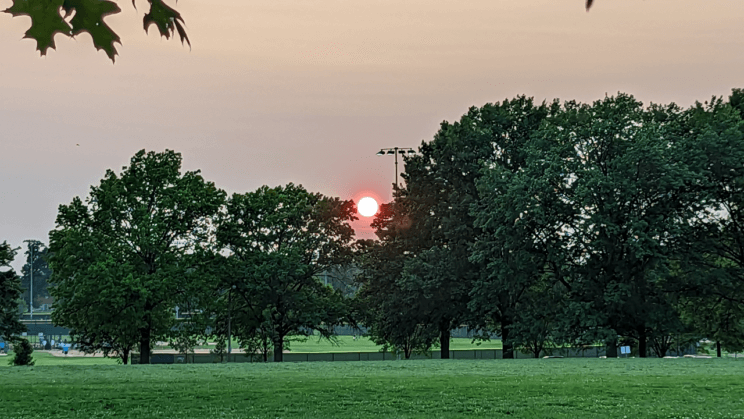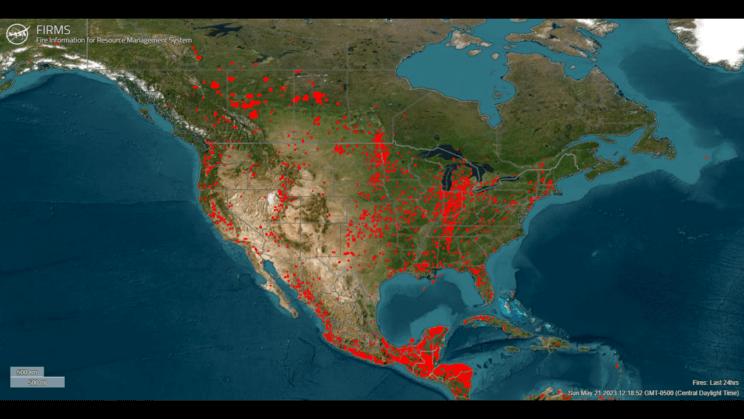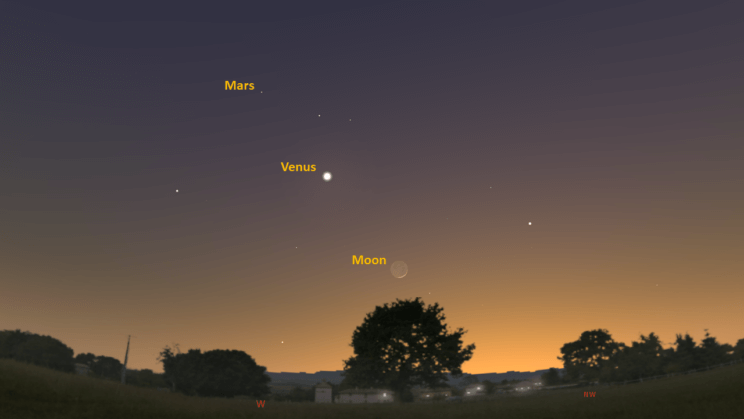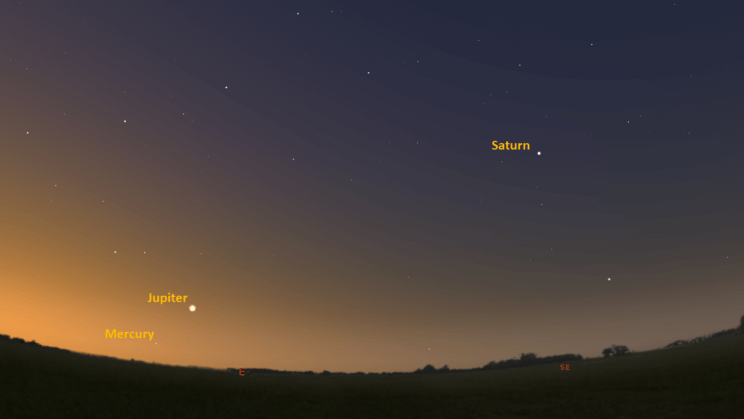This is the Saint Louis Science Center’s NIGHT SKY UPDATE for the week of Friday, May 19, 2023.
Information updated weekly or as needed.
Times given as local St. Louis time which is Central Daylight Time (CDT). For definitions of terminology used in the night sky update, click the highlighted text. If relying on times posted in Universal Time (UT), St. louis is -5 hours when CDT.
Public Telescope Viewings
As part of the Saint Louis Science Center’s First Fridays, weather permitting, the St. Louis Astronomical Society and the Science Center will set up a number of telescopes outdoors and be on-hand to answer your questions. Telescope viewing begins once it is dark. Regardless of the weather on June 2, join us indoors in our planetarium theater for “The Sky Tonight”. Showtime is at 7 p.m.
Observing Highlight of the Week

Sun nearing sunset seen from the McDonnell Planetarium on May 18, 2023. Image credit: Eric Gustafson
If you have watched the news lately you will know that our Canadian friends to the north are dealing with several wildfires that are spreading across the provinces of Alberta, Saskatchewan and British Columbia. It is the start of wildfire season in these provinces, but like other wildfire prone areas, the occurrence and intensity of these fires has been on the rise. Lightning strikes and human causation are traditionally the cause of wildfires, but record setting drought conditions and increasing temperatures are causing an increase of their severity.
Wildfires are important for ecosystems as they help replenish nutrients and create new habitats. Unfortunately, climate change has led to an increase in heat, extended drought conditions and atmospheric thirst. The latter of these factors, atmospheric thirst, is described as an increase in evaporative demand or the atmosphere’s ability to pull moisture from the ground. All these factors have caused an increase in the drying of organic matter which is what fuels wildfires. This results in longer and more active fire seasons. Recent research has revealed that an increase in fires can lead to a decrease in precipitation. As fires burn, they release increased amounts of aerosols into the atmosphere. This results in a diffusion of available water vapor diminishing the amount of condensation of water vapor on cloud condensation nuclei (CCN). The decrease in condensation on CCN leads to a decrease in precipitation creating a feedback loop. More fires mean less rain.
When fires like those in Canada or other types of disasters are so far away, it can be difficult to appreciate how they can have lasting impacts where you live. As it turns out, localized events can have enormous impacts on global systems. You may have noticed recently that the Sun has appeared a fiery red as we near sunset. This is because smoke from the wildfires in Canada has moved southward into the United States. Global weather patterns can carry particulates such as smoke from fires, aerosols from volcanic eruptions, and dust from Africa around the world. These particulates can impact climate, weather and health conditions in far off locations.
Where you often see evidence of these impacts are the signs on the roadside that state today is a green day or today is an orange day. These are Air Quality Index (AQI) signs that present the current forecast for air quality. The AQI is based on a scale of 0 to 500 that measures how much ground level ozone and particle pollution is in the air. These indices are important to track because they have implications for respiratory health. Those that are especially prone to the quality of air are those with respiratory issues, along with the old and young members of populations. The AQI is color coded which makes it easy to understand current conditions. You can learn more about the AQI at https://www.airnow.gov/aqi/aqi-basics/ and the American Lung Association. The greatest impact the Canadian fires have had are in Canada, but we are starting to see air quality conditions become hazardous in many northern and midwestern states.
While not as severe as respiratory health, increased particles in the air can dramatically change how things appear around us. Sunset and sunrises are an easy way to monitor how far reaching the effects of increased particulates in the atmosphere can be. Since the smoke from Canada has drifted southward, the Sun has appeared quite red when nearing sunset.
To understand why we need to explore how our atmosphere distorts light. Many might say the atmosphere is invisible. Where that appears to be true, it is better to describe it as the atmosphere is transparent. We may not see the atmosphere around us, but it is there. If you wave your hand in front of your face, you will feel wind. Wind is simply the atmosphere moving. When you push your hand through the atmosphere, you are displacing and accelerating the gases of the atmosphere.
Air is made up of many molecules of nitrogen (72%), oxygen (21%) and other trace gases. As light passes through these gases, it can be scattered by air molecules. Light from the Sun is not a single color but rather is made up of all wavelengths from radio waves to gamma rays. Most of this we are blind to, but there is a small range of wavelengths we are sensitive to which is called the visible light spectrum. The visible light spectrum is often visible after a rainstorm when white light from the Sun is refracted by raindrops creating a rainbow. Red is the longest wavelength we can see while blue is the shortest. Violet is a shorter wavelength than blue, but our eyes are not very sensitive to violet light. Air molecules scatter all the wavelengths, but the shorter the wavelength is the more likely it is to be scattered. Another way to state this is blue light is scattered more than red light is and as a result the sky looks blue in the daytime. The type of scattering that causes the blue appearance of the sky is called Rayleigh Scattering.
As sunset approaches, the Sun begins to shift towards an orange color. This occurs because you are looking through more atmosphere when observing low to the horizon. This results in more scattering of light. Blue light from the Sun is not completely gone but more of it is scattered. When you add more particulates to the atmosphere, this will increase the amount of scattering that normally occurs, making the Sun look redder.
The density of the smoke particles in the atmosphere will fluctuate over time causing the Sun’s appearance to change a little bit each day. I expect we will continue to see the effects from the smoke for a while as the fires continue to burn. Hopefully, they will be under control sooner than later, but for now they remain a sobering reminder of how dangerous climatic changes can be. Below you will find a map of active fires and hotspots throughout North America. It may come as a surprise that there are several closer to home than you may expect. Significant portions of Missouri and Iowa have shifted into drought conditions. You can find a current map of the conditions at U.S. Drought Monitor. If you visit this website, I encourage you to click on your state to see drought conditions in detail for your area. Additionally, below the map of drought conditions, they have compiled historical effects the different levels of drought have on each state.

Active hotspot seen across North America as of May 21, 2023. Many of these are active fires but they can also be due to hot smoke, agriculture and other sources. Image credit: NASA, FIRMS
The Sun and Moon

The Moon as seen from the International Space Station, on July 31, 2011.
Credit: NASA
Sunrise is at 5:46 a.m. on Friday, May 19 and sunset is at 8:09 p.m. providing us with roughly 14.5 hours of daylight. Even after sunset, light from the Sun will dimly illuminate our sky for roughly 1 hour and 50 minutes. This period is called twilight, which ends around 9:59 p.m. this week. For those with a sundial, local noon occurs around 12:57 p.m. this week.
| Day | Sunrise | Sunset | ||||||||||
|---|---|---|---|---|---|---|---|---|---|---|---|---|
| 19-May | 5:46 a.m. | 8:09 p.m. | ||||||||||
| 20-May | 5:45 a.m. | 8:10 p.m. | ||||||||||
| 21-May | 5:44 a.m. | 8:11 p.m. | ||||||||||
| 22-May | 5:44 a.m. | 8:12 p.m. | ||||||||||
| 23-May | 5:43 a.m. | 8:13 p.m. | ||||||||||
| 24-May | 5:42 a.m. | 8:13 p.m. | ||||||||||
| 25-May | 5:42 a.m. | 8:14 p.m. | ||||||||||
| 26-May | 5:41 a.m. | 8:15 p.m. | ||||||||||
| 27-May | 5:40 a.m. | 8:16 p.m. |
Moon
Moonrise for Friday, May 20 is at 6:10 a.m. and moonset occurs at 9:42 p.m. On Friday, May 20, the Moon will exhibit a waxing crescent phase with 2% disk illumination. First quarter moon occurs on May 27, 2023, at 10:22 a.m.
International Space Station (ISS) Observing

There are several visible passes of ISS from St. Louis for the week of May 19. They occur during late evening hours. The best passes for this week are listed below. Use the table below for information about these passes.
Catch ISS from St. Louis starting Friday, May 19
| Date | Starts | Max. altitude | Ends | |||||||
|---|---|---|---|---|---|---|---|---|---|---|
| Time | Alt. | Az. | Time | Alt. | Az. | Time | Alt. | Az. | ||
| 25 May | -2.5 | 22:49:02 | 10 | NW | 22:51:40 | 40 | N | 22:51:40 | 40 | N |
| 26 May | -2.2 | 22:00:39 | 10 | NNW | 22:03:38 | 29 | NNE | 22:04:49 | 23 | ENE |
| 27 May | -2.5 | 22:48:33 | 10 | WNW | 22:50:51 | 38 | WNW | 22:50:51 | 38 | WNW |
Magnitude (Mag): The Measure of brightness for a celestial object. The lower the value is, the brighter the object will be.
Altitude (Alt): The angle of a celestial object measured upwards from the observer’s horizon.
Azimuth (Az): The direction of a celestial object, measured clockwise from an observer’s location with north being 0°, east being 90°, south being 180° and west being 270°.
For information about ISS flyovers and other visible satellites, visit www.heavens-above.com
Detailed information regarding all unmanned exploration of our universe, missions past, present, and planned, can be found at Jet Propulsion Laboratories:
The Visible Planets

Looking west at 8:45 p.m. on May 21, 2023. Credit: Stellarium, EG

Looking Southeast at 5:00 a.m. on May 22, 2023. Credit: Stellarium, EG
This week, four naked eye planets will be visible. Venus and Mars are found in the west after sunset. Saturn and Jupiter are visible in the southeast and east before sunrise.
Venus
Venus is well into its current evening apparition. Venus will be a bright target in the west after sunset until August 2023 when it approaches inferior conjunction. This week, look for Venus in the west about 20 minutes after sunset. Venus sets at 11:40 p.m.
Mars
Mars now rises before sunset, becoming visible once it is dark. Look for it high in the west about 30 minutes after sunset. Mars sets at 12:29 a.m.
Jupiter
Jupiter is starting another apparition. It rises about an hour before sunrise so for many it will likely still be below tree lines and buildings. The giant world will be roughly 15° above the eastern horizon 30 minutes before sunrise.
Saturn
Saturn rises at 2:11 a.m. Start looking for Saturn about 30 minutes after it rises. If you have lots of trees or buildings, you may have to wait an hour or so after it rises before it will be visible.
James S. McDonnell Planetarium
Night Sky Update: May 19-27, 2023






